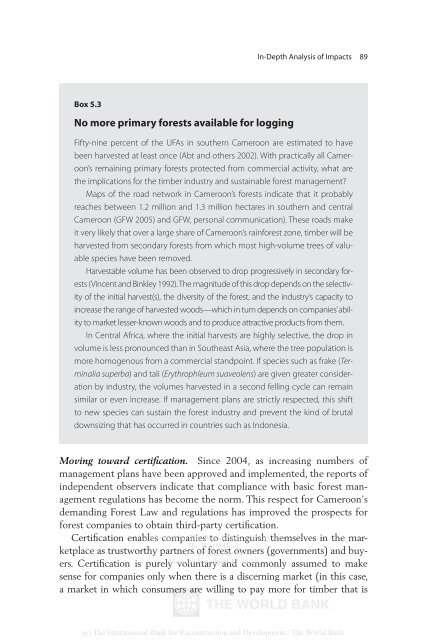The Rainforests of Cameroon - PROFOR
The Rainforests of Cameroon - PROFOR
The Rainforests of Cameroon - PROFOR
- No tags were found...
You also want an ePaper? Increase the reach of your titles
YUMPU automatically turns print PDFs into web optimized ePapers that Google loves.
In-Depth Analysis <strong>of</strong> Impacts 89Box 5.3No more primary forests available for loggingFifty-nine percent <strong>of</strong> the UFAs in southern <strong>Cameroon</strong> are estimated to havebeen harvested at least once (Abt and others 2002). With practically all <strong>Cameroon</strong>’sremaining primary forests protected from commercial activity, what arethe implications for the timber industry and sustainable forest management?Maps <strong>of</strong> the road network in <strong>Cameroon</strong>’s forests indicate that it probablyreaches between 1.2 million and 1.3 million hectares in southern and central<strong>Cameroon</strong> (GFW 2005) and GFW, personal communication). <strong>The</strong>se roads makeit very likely that over a large share <strong>of</strong> <strong>Cameroon</strong>’s rainforest zone, timber will beharvested from secondary forests from which most high-volume trees <strong>of</strong> valuablespecies have been removed.Harvestable volume has been observed to drop progressively in secondary forests(Vincent and Binkley 1992). <strong>The</strong> magnitude <strong>of</strong> this drop depends on the selectivity<strong>of</strong> the initial harvest(s), the diversity <strong>of</strong> the forest, and the industry’s capacity toincrease the range <strong>of</strong> harvested woods—which in turn depends on companies’ abilityto market lesser-known woods and to produce attractive products from them.In Central Africa, where the initial harvests are highly selective, the drop involume is less pronounced than in Southeast Asia, where the tree population ismore homogenous from a commercial standpoint. If species such as frake (Terminaliasuperba) and tali (Erythrophleum suaveolens) are given greater considerationby industry, the volumes harvested in a second felling cycle can remainsimilar or even increase. If management plans are strictly respected, this shiftto new species can sustain the forest industry and prevent the kind <strong>of</strong> brutaldownsizing that has occurred in countries such as Indonesia.Moving toward certification. Since 2004, as increasing numbers <strong>of</strong>management plans have been approved and implemented, the reports <strong>of</strong>independent observers indicate that compliance with basic forest managementregulations has become the norm. This respect for <strong>Cameroon</strong>’sdemanding Forest Law and regulations has improved the prospects forforest companies to obtain third-party certification.Certification enables Delivered companies by <strong>The</strong> World to distinguish Bank e-library themselves to: in the marketplaceas trustworthy partners IP : <strong>of</strong> 192.86.100.34 forest owners (governments) and buy-<strong>The</strong> World Bankers. Certification is purely Mon, voluntary 09 Nov 2009 and 17:06:18 commonly assumed to makesense for companies only when there is a discerning market (in this case,a market in which consumers are willing to pay more for timber that is(c) <strong>The</strong> International Bank for Reconstruction and Development / <strong>The</strong> World Bank
















